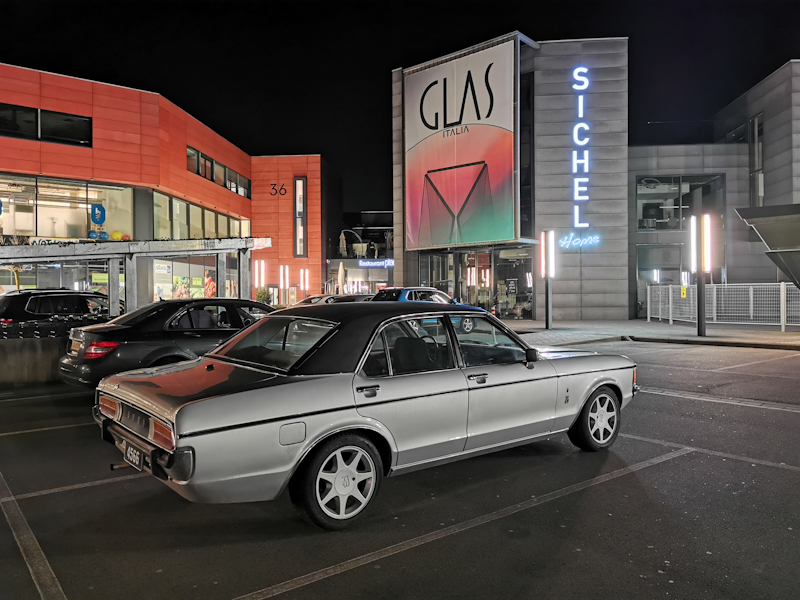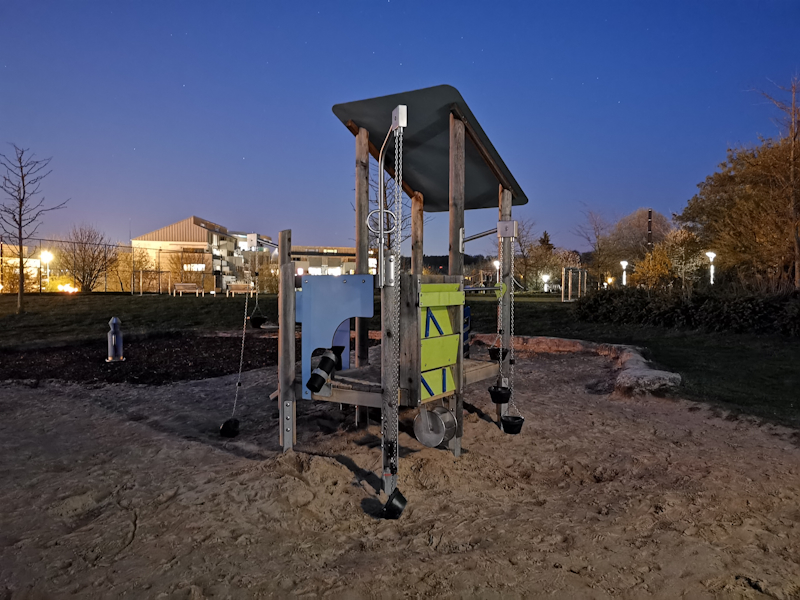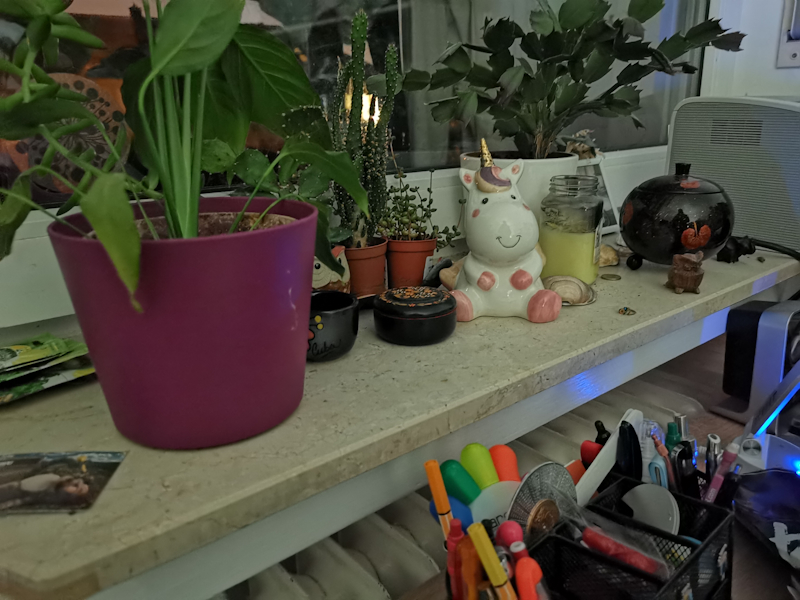The Huawei P30 & P30 Pro Reviews: Photography Enhanced
by Andrei Frumusanu on April 18, 2019 9:00 AM EST- Posted in
- Mobile
- Smartphones
- Huawei
- P30
- P30 Pro
Camera - Low Light Evaluation
Low-light photography is where Huawei’s strengths lie. Starting with the P20 the company was a pioneer in terms of computational photography, not only was the company able to improve low-light capture on smartphones with “regular” camera sensors, it also marked the start of customised camera sensor hardware that was able to achieve much higher ISO sensitivity than any other phone camera on the market.
Huawei’s rationale for adopting the RYYB sensor was in order to improve the low-light capabilities of the phone, promising 30% increased light capture. The P30 Pro in particular we’re expecting some massive low-light capture improvements, not only due to the new sensor but also thanks to the wider aperture as well as the integration of OIS in the sensor – something we haven’t seen in Huawei devices in several years.

[ P30 Pro ] - [ P30 ]
[ P20 Pro ] - [ P20 ] - [ Mate 20 Pro ]
[ S10+ (S) ] - [ S10+ (E) ] - [ S9+ (S) ]
[ G8 ] - [ G7 ] - [ V40 ]
[ View20 ] - [ OnePlus 6T ] - [ Pixel 3 ] - [ iPhone XS ]
As a note, shooting in 40MP mode in low light is pretty much a futile exercise, as the sensor just isn’t able to capture enough light without help of pixel binning down to 10MP.
Huawei had already a lead in low-light capture with its previous devices, and the only viable competition was the new Pixel’s Night Sight mode. With the P30s, Huawei now extends this lead. While not exactly reaching the level of detail on the Pixel 3’s Night Sight mode, the P30s both show very large improvements over their 40MP predecessors all while being leagues ahead of other traditional camera sensors.
It’s to be noted the Pixel 3’s Night mode was way off in terms of colour temperature, and the Huawei phones had a more correct representation of the orange illumination of sodium street lamps.
At certain brightness levels such as in this scene, Night mode on the Huawei phones can have a detrimental effect and results in blurred details, even though it produces a brighter image.
Both wide angle modules struggle in low-light, however Night mode can help out a lot. Again between the four wide angle shots between the P30 Pro and P30 we’re getting very different results, with the smaller P30 producing brighter results for some reason.

[ P30 Pro ] - [ P30 ]
[ P20 Pro ] - [ P20 ] - [ Mate 20 Pro ]
[ S10+ (S) ] - [ S10+ (E) ] - [ S9+ (S) ]
[ G8 ] - [ G7 ] - [ V40 ]
[ View20 ] - [ OnePlus 6T ] - [ Pixel 3 ] - [ iPhone XS ]
In this parking lot, again in regular shooting mode the P30s are ahead of the competition, with the only real contender being Google Night mode. Switching on the P30’s we see better exposure and shadows, although Google continues to retain a detail lead.
On the wide-angle camera, Huawei’s Night mode remains unchallenged. LG’s G8 comes near in terms of exposure, however it lacks details and is very noisy. Samsung’s new cameras are lagging far behind in this aspect.

[ P30 Pro ] - [ P30 ] - [ P20 Pro ] - [ P20 ]
[ Mate 20 Pro ] - [ S10+ (S) ] - [ S10+ (E) ] - [ S9+ (S) ]
[ G8 ] - [ G7 ] - [ V40 ] - [ View20 ]
[ OnePlus 6T ] - [ Pixel 3 ] - [ iPhone XS ]
This shot is quite challenging due to the high dynamic range between the illuminated truck cabins and the dark lower parts of the image. In the default mode, both P30s produced too dark images with not sufficient dynamic range, however on the P30 Pro the phone captures an evident HDR processed picture. I didn’t do anything special between takes, and this is something I’ve experienced in the past with Huawei devices. Unfortunately the phone has like a dozen capture modes which get triggered depending by scene, and one has little control over it and the result can only be determined by the resulting EXIF information in the image.
When in Night mode, the P30’s produce better shadows than the Pixel, however the latter continues to have an advantage in terms of detail. The Pixel is also a tad too saturated with the blue of the trucks, while the Huawei phones are too undersaturated.
Camera - Extreme Low-Light Evaluation
Moving on to extreme low-light conditions, these are scenarios we traditionally didn’t expect smartphones cameras to be effective at all. Most phones here will produce a dark image and are at their limit in terms of light capture. To be able to perform here, you need help of specialised sensors or sneaky computational photography.

[ P30 Pro ] - [ P30 ] - [ P20 Pro ] - [ P20 ]
[ Mate 20 Pro ] - [ S10+ (S) ] - [ S10+ (E) ] - [ S9+ (S) ]
[ G8 ] - [ G7 ] - [ V40 ] - [ View20 ]
[ OnePlus 6T ] - [ Pixel 3 ] - [ iPhone XS ]
In our playground shot in the night, the P30 Pro pulls in some incredible amount of light. The auto shot comes in at ISO25600, however due to the noise reduction you’re hard to notice any noise at all.
The smaller P30 had issues in terms of focusing correctly, and thus it resulted in a blurry shot.
Switching on Night mode, the P30 Pro is able to capture some outstanding results far ahead of any other device. The inclusion of OIS on the P30 Pro really augments the Night mode, and while in past devices we saw more blurred details in this mode, on the P30 Pro things actually get a lot sharper.
The Pixel 3’s Night mode can’t keep up here as even if it’s algorithmically superior, the sensor just isn’t able to capture enough input data.
Comparing the P30 Pro to say the iPhone XS really showcases the massive differences that we’re currently seeing in the competitive landscape, and the differences are absurd.

[ P30 Pro ] - [ P30 ] - [ P20 Pro ] - [ P20 ]
[ Mate 20 Pro ] - [ S10+ (S) ] - [ S10+ (E) ] - [ S9+ (S) ]
[ G8 ] - [ G7 ] - [ V40 ] - [ View20 ]
[ OnePlus 6T ] - [ Pixel 3 ] - [ iPhone XS ]
In this last in-door shot, the absurdity continues as the P30s are just in a different league. Again between the P30 Pro and the P30 we see the former take advantage of OIS and a resulting sharper picture.
Both phones in the auto mode area already ahead of the pack in terms of capture ability, but turning on the Night mode further widens the gap, achieving even more detail. I was actually aghast to see how natural the resulting image was, yet the actual room was much darker than what’s represented here.
P30 Pro & P30 Low-Light Evaluation Conclusion
Overall, Huawei here hit it out of the park in terms of low-light capture. The new sensors as well as the new optics on the P30 Pro really put the devices far ahead of the curve in terms of what they’re able to produce.
OIS for the P30 Pro in particular has notable benefits, especially when paired together with the Night mode. Huawei’s processing for Night mode is a lot brighter than previous devices. Google still seems to have the better algorithms and resulting Night Sight pictures can be a lot sharper and more detailed than Huawei’s Night mode, however under a certain threshold of low light even the Pixel 3 can’t keep up with Huawei’s new camera modules.
The P30 Pro is the best low-light camera smartphone on the market, with the P30 closely following behind. The competition really needs to scramble to improve their computational photography abilities, and be at least be able to match Google’s implementation. If we’ll see other vendors employ special sensors such as employed by Huawei is to be seen, but for now the company’s cameras are in a class of their own in low-light.










85 Comments
View All Comments
jabber - Thursday, April 18, 2019 - link
I have to remind myself...these are phones?StrangerGuy - Thursday, April 18, 2019 - link
Gotta really see the reaction from the DSLR diehards on this one.philehidiot - Thursday, April 18, 2019 - link
I don't understand. DSLR photography is a totally different ballgame to mobile phone photography. I'd say phones like this make compact cameras almost totally irrelevant.DSLR photography is a different kettle of fish - can you even alter the aperture on these phones? Now if you're buying a DSLR for casual photography and never plan to change from the kit lens and just keep it on auto, then yeh... these phones are kind of a kick in the teeth. To those of us for whom using a DSLR is an art and we have insane macro lenses, tripods and occasionally attach them to a telescope.... a good DSLR is going nowhere.
Also, the qualitative beauty of the dynamic range of a DSLR is something subtle and can make or break a photo. Phones tend to go for brash, impactful but ultimately flat photos. You go "wow" when you see them but you can't compare them to the subtle beauty created by a DSLR sensor when used properly by someone who actually cares to do more than point and shoot.
emn13 - Thursday, April 18, 2019 - link
DSLR's are almost certainly dead in the medium to near term, even for professional use. What I *really* can't wait for is the kind of imaging that's going to possible once this kind of advanced processing is *combined* with higher-end optical systems, as should be possible even on compacts and mirrorless systems. Full-frame is all hyped up and stuff, but the optical sweet spot is almost certainly smaller; the kind of apertures possible even on aps-C and 1-inch sensors are quite sufficient for almost impractically small depth of field; and really, that's optically the *only* advantage there is (at least - assuming people would bother to sell high-end lenses for smaller sensors, which they currently do not).I mean, can you imagine something like this on even just an rx-100 style body? Ideally available in versions with zoom or prime? It would be completely bonkers, and portability isn't that much worse than a modern smartphone.
Frenetic Pony - Thursday, April 18, 2019 - link
Ahh, the usual internet "experts". The hilarious part is even thinking SLR's are somehow cutting edge, which shows how behind everyone here is. Every camera company now has a mirrorless version, which actually different as it's not an SLR at all, for one!I'm just a casual, hobbyist photographer. But my older, APSC mirrorless camera absolutely CRUSHES my Galaxy s8 in terms of image quality, even with the custom Pixel camera APK installed. And I want a newer camera as I'm severely limited in dynamic range, lowlight image quality, and what resolution I can get good images at (4k just isn't doable). Not to mention my image edges are still soft even with a nice prime lens.
Maybe in a few years, when those smartphone and "Light" partnerships show up, and they pair up like 5 cameras into one image successfully, then big sensor mirrorless cameras time will be limited. But for now, there's no contest.
philehidiot - Thursday, April 18, 2019 - link
How arrogant. So we are using DSLR as a descriptor for brevity and you decide to use that as some way of proving we are all wrong. No, there just isn't a handy accronym for mirrorless big ass camera with interchangeable lenses. You know perfectly well what we were discussing so why not add to that discussion rather than being picky for the sake of it? And yes, a decent large sensor will, in the right hands, destroy a phone but they are different propositions.tuxRoller - Friday, April 19, 2019 - link
https://petapixel.com/2018/03/14/death-dslrs-near/s.yu - Friday, April 19, 2019 - link
I advise you to stop reading Petapixel, those people are more amateur than GSMArena (who do a pretty good job despite the name) and Androidauthority (who are real amateurs) when it comes to image quality review so I don't know if they're actually qualified.jabber - Friday, April 19, 2019 - link
I think I've been reading 'the death of DSLRs' for at least 12 years. If it is a death its a very loooooong one.zodiacfml - Monday, April 22, 2019 - link
No. emn13 knows what he's talking about. I'm I die hard RAW shooter of APSC cameras but high end smartphones definitely comes close considering the size, features, and cost. I did not expect smartphones to come this close so soon as I always believed size is everthing in image quality.Limited to a 4k display, it is really close to an APSC camera with a kit lens.